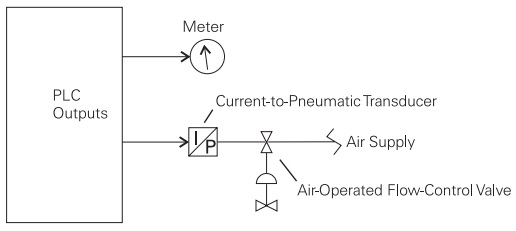Terminology of PLCs
The language of PLCs consists of a commonly used set of terms; many of which are unique to PLCs. In order to understand the ideas and concepts of PLCs, an understanding of these terms in necessary.
Sensor
A sensor is a device that converts a physical condition into an electrical signal for use by the PLC. Sensors are connected to the input of a PLC. A pushbutton is one example of a sensor that is conected to the PLC input. An electical signal is sent from the pushbutton ton the PLC indicating the condition (open/closed) of the pushbutton contacts.
Actuators
Actuators convert an electrical signal from the PLC into a physical condition. Actuators are connected to the PLC output. A motor starter is one example of an actuator that is conected to the PLC output. Depending on the output PLC signal the motor starter will either start or stop the motor.
Discrete Input
A discrete input, also referred to as a digital input, is an input that is either in an ON or OFF condition. Oushbuttons, toggle switches, limit switches, proximity switches, and contact closures are examples of discrete sensors which are connected to the PLCs discrete or digital inputs. In the ON condition a discrete input may be referred to as a logic 1 a logic high. In the OFF condition a discrete input may be referred to as a logic 0 or a logic low.
A Normally Open (NO) pushbutton is used in te folloing example. One side of the pushbutton is connected to the first PLC input. The other side of the pushbutton is connected to an internal 24 VDC power supply. Many PLCs require a sparate power supply to power the iputs. In the open state, no voltage is present at the PLC input. This is the OFF vondition. When the pushbutton is depressed, 24 VDC id applied to the PLC input. This is the ON condition.
Analog Inputs
An analog input is an input signal that has a continous signal. Typical analog inputs may vary from 0 to 20 miiamps, 4 to 29 miliamps, or 0 to 10 volts. In the following example, a level transmitter monitors the level of loquid in atank Depending on the level transmitter, the signal to the PLC can either increase or decrease as the level increases or decreases.
Discrete Outputs
A descrete output is an output that is either in an ON or OFF condition. Solenoids, contactor coils, and lamps are ecamples of actuator devices connected to discrete outputs. Discrete outputs may also be referred to as digital output. In the following ecample, a lamp can be turned on or off by the PLC output it is connected to.
Analog Outputs
An analog output is an output signal that has a continous signal. The output may be as simple as a 0-10 VDC level that drives an analog meter. Examples of analog meter outputs are speed, weight, and temperature. The output signal may also be used on more complex applications such as a current-to- pneumatic transducer that controls an air-operated flow-control valve.
CPU
The central processor unit (CPU) is a microprocessor system that cotains the system memory and is the PLC decision-making unit. The CPU monitors the inputs and makes decision based on instuctions held in the program memory. The CPU performs relay, counting, timing, data comparison, and sequential operations.
Retyped from: Guide Book of SIEMENS Step 2000 Basic of PLCs
Sensor
A sensor is a device that converts a physical condition into an electrical signal for use by the PLC. Sensors are connected to the input of a PLC. A pushbutton is one example of a sensor that is conected to the PLC input. An electical signal is sent from the pushbutton ton the PLC indicating the condition (open/closed) of the pushbutton contacts.
Actuators
Actuators convert an electrical signal from the PLC into a physical condition. Actuators are connected to the PLC output. A motor starter is one example of an actuator that is conected to the PLC output. Depending on the output PLC signal the motor starter will either start or stop the motor.
Discrete Input
A discrete input, also referred to as a digital input, is an input that is either in an ON or OFF condition. Oushbuttons, toggle switches, limit switches, proximity switches, and contact closures are examples of discrete sensors which are connected to the PLCs discrete or digital inputs. In the ON condition a discrete input may be referred to as a logic 1 a logic high. In the OFF condition a discrete input may be referred to as a logic 0 or a logic low.
A Normally Open (NO) pushbutton is used in te folloing example. One side of the pushbutton is connected to the first PLC input. The other side of the pushbutton is connected to an internal 24 VDC power supply. Many PLCs require a sparate power supply to power the iputs. In the open state, no voltage is present at the PLC input. This is the OFF vondition. When the pushbutton is depressed, 24 VDC id applied to the PLC input. This is the ON condition.
Analog Inputs
An analog input is an input signal that has a continous signal. Typical analog inputs may vary from 0 to 20 miiamps, 4 to 29 miliamps, or 0 to 10 volts. In the following example, a level transmitter monitors the level of loquid in atank Depending on the level transmitter, the signal to the PLC can either increase or decrease as the level increases or decreases.
Discrete Outputs
A descrete output is an output that is either in an ON or OFF condition. Solenoids, contactor coils, and lamps are ecamples of actuator devices connected to discrete outputs. Discrete outputs may also be referred to as digital output. In the following ecample, a lamp can be turned on or off by the PLC output it is connected to.
An analog output is an output signal that has a continous signal. The output may be as simple as a 0-10 VDC level that drives an analog meter. Examples of analog meter outputs are speed, weight, and temperature. The output signal may also be used on more complex applications such as a current-to- pneumatic transducer that controls an air-operated flow-control valve.
CPU
The central processor unit (CPU) is a microprocessor system that cotains the system memory and is the PLC decision-making unit. The CPU monitors the inputs and makes decision based on instuctions held in the program memory. The CPU performs relay, counting, timing, data comparison, and sequential operations.
Retyped from: Guide Book of SIEMENS Step 2000 Basic of PLCs











Comments
Post a Comment